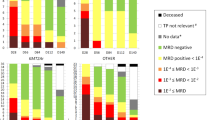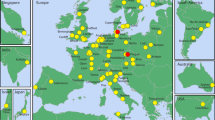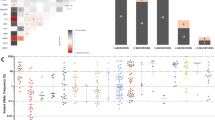Abstract
An estimated 10% of acute leukemias carry mixed-lineage leukemia (MLL) fusion genes. Approximately 50 different fusion partners of the MLL gene have already been molecularly identified. These leukemias are commonly regarded as high-risk cases and are treated accordingly with intensified therapy regimens, including hematopoietic stem cell transplantation. However, a subset of patients may achieve long-term remissions with conventional therapy. Monitoring minimal residual disease (MRD) is undoubtedly of great value in clinical decision making, also in the pre- and post-transplant setting. Here, we describe a novel method for detecting MRD in leukemias with MLL aberrations. The method is based on monitoring patient-specific chromosomal breakpoint DNA sequences. This has several advantages over other methods that are based either on detecting specific RNA molecules of MLL fusion genes or on surrogate markers. An accurate and absolute quantification of the MRD level is possible. No reference to housekeeping genes is necessary and the target structure is much more stable than any mRNA fusion transcript.
This is a preview of subscription content, access via your institution
Access options
Subscribe to this journal
Receive 12 print issues and online access
$259.00 per year
only $21.58 per issue
Buy this article
- Purchase on Springer Link
- Instant access to full article PDF
Prices may be subject to local taxes which are calculated during checkout



Similar content being viewed by others
References
Pui CH, Relling MV, Downing JR . Acute lymphoblastic leukemia. N Engl J Med 2004; 350 (15): 1535–1548.
Schoch C, Schnittger S, Klaus M, Kern W, Hiddemann W, Haferlach T . AML with 11q23/MLL abnormalities as defined by the WHO classification: incidence, partner chromosomes, FAB subtype, age distribution, and prognostic impact in an unselected series of 1897 cytogenetically analyzed AML cases. Blood 2003; 102 (7): 2395–2402.
Gilliland DG, Jordan CT, Felix CA . The molecular basis of leukemia. Hematology (Am Soc Hematol Educ Program) 2004, 80–97.
Meyer C, Schneider B, Jakob S, Strehl S, Attarbaschi A, Schnittger S et al. The MLL recombinome of acute leukemias. 2005, submitted.
Pui CH, Chessells JM, Camitta B, Baruchel A, Biondi A, Boyett JM et al. Clinical heterogeneity in childhood acute lymphoblastic leukemia with 11q23 rearrangements. Leukemia 2003; 17 (4): 700–706.
Wetzler M, Dodge RK, Mrozek K, Carroll AJ, Tantravahi R, Block AW et al. Prospective karyotype analysis in adult acute lymphoblastic leukemia: the cancer and leukemia Group B experience. Blood 1999; 93 (11): 3983–3993.
Cimino G, Elia L, Mancini M, Annino L, Anaclerico B, Fazi P, et al., for the GIMEMA group. Clinico-biologic features and treatment outcome of adult pro-B-ALL patients enrolled in the GIMEMA 0496 study: absence of the ALL1/AF4 and of the BCR/ABL fusion genes correlates with a significantly better clinical outcome. Blood 2003; 102 (6): 2014–2020.
Ludwig WD, Rieder H, Bartram CR, Heinze B, Schwartz S, Gassmann W et al. Immunophenotypic and genotypic features, clinical characteristics, and treatment outcome of adult pro-B acute lymphoblastic leukemia: results of the German multicenter trials GMALL 03/87 and 04/89. Blood 1998; 92 (6): 1898–1909.
van Dongen JJ, Macintyre EA, Gabert JA, Delabesse E, Rossi V, Saglio G et al. Standardized RT-PCR analysis of fusion gene transcripts from chromosome aberrations in acute leukemia for detection of minimal residual disease. Report of the BIOMED-1 Concerted Action: investigation of minimal residual disease in acute leukemia. Leukemia 1999; 13 (12): 1901–1928.
Gabert J, Beillard E, van der Velden VH, Bi W, Grimwade D, Pallisgaard N et al. Standardization and quality control studies of ‘real-time’ quantitative reverse transcriptase polymerase chain reaction of fusion gene transcripts for residual disease detection in leukemia – a Europe Against Cancer program. Leukemia 2003; 17 (12): 2318–2357.
Schwartz S, Rieder H, Schläger B, Burmeister T, Fischer L, Thiel E . Expression of the human homologue of rat NG2 in adult acute lymphoblastic leukemia: close association with MLL rearrangement and a CD10(−)/CD24(−)/CD65s(+)/CD15(+) B-cell phenotype. Leukemia 2003; 17 (8): 1589–1595.
Bene MC, Castoldi G, Knapp W, Ludwig WD, Matutes E, Orfao A et al. Proposals for the immunological classification of acute leukemias. European Group for the Immunological Characterization of Leukemias (EGIL). Leukemia 1995; 9: 1783–1786.
Andersson A, Höglund M, Johansson B, Lassen C, Billström R, Garwicz S et al. Paired multiplex reverse-transcriptase polymerase chain reaction (PMRT-PCR) analysis as a rapid and accurate diagnostic tool for the detection of MLL fusion genes in hematologic malignancies. Leukemia 2001; 15 (8): 1293–1300.
Meyer C, Schneider B, Reichel M, Angermueller S, Strehl S, Schnittger S et al. Diagnostic tool for the identification of MLL rearrangements including unknown partner genes. Proc Natl Acad Sci USA 2005; 102 (2): 449–454.
Fehse B, Chukhlovin A, Kuhlcke K, Marinetz O, Vorwig O, Renges H et al. Real-time quantitative Y chromosome-specific PCR (QYCS-PCR) for monitoring hematopoietic chimerism after sex-mismatched allogeneic stem cell transplantation. J Hematother Stem Cell Res 2001; 10 (3): 419–425.
Breslauer KJ, Frank R, Blocker H, Marky LA . Predicting DNA duplex stability from the base sequence. Proc Natl Acad Sci USA 1986; 83 (11): 3746–3750.
Sugimoto N, Nakano S, Yoneyama M, Honda K . Improved thermodynamic parameters and helix initiation factor to predict stability of DNA duplexes. Nucleic Acids Res 1996; 24 (22): 4501–4505.
van der Velden VHJ, Hochhaus A, Cazzaniga G, Szczepañski T, Gabert J, van Dongen JJM . Detection of minimal residual disease in hematologic malignancies by real-time. Quantitative PCR: principles, approaches, and laboratory aspects. Leukemia 2003; 17: 1013–1034.
Nilson I, Lochner K, Siegler G, Greil J, Beck JD, Fey GH et al. Exon/intron structure of the human ALL-1 (MLL) gene involved in translocations to chromosomal region 11q23 and acute leukaemias. Br J Haematol 1996; 93 (4): 966–972.
van Dongen JJ, Langerak AW, Brüggemann M, Evans PA, Hummel M, Lavender FL et al. Design and standardization of PCR primers and protocols for detection of clonal immunoglobulin and T-cell receptor gene recombinations in suspect lymphoproliferations: report of the BIOMED-2 Concerted Action BMH4-CT98-3936. Leukemia 2003; 17 (12): 2257–2317.
Szczepañski T, Willemse MJ, Brinkhof B, van Wering ER, van der Burg M, van Dongen JJM . Comparative analysis of Ig and TCR gene rearrangements at diagnosis and at relapse of childhood precursor-B-ALL provides improved strategies for selection of stable PCR targets for monitoring of minimal residual disease. Blood 2002; 99 (7): 2315–2323.
Darlow JM, Stott DI . V(H) replacement in rearranged immunoglobulin genes. Immunology 2005; 114 (2): 155–165.
Schnittger S, Wörmann B, Hiddemann W, Griesinger F . Partial tandem duplications of the MLL gene are detectable in peripheral blood and bone marrow of nearly all healthy donors. Blood 1998; 92 (5): 1728–1734.
Döhner K, Tobis K, Ulrich R, Fröhling S, Benner A, Schlenk RF et al. Prognostic significance of partial tandem duplications of the MLL gene in adult patients 16 to 60 years old with acute myeloid leukemia and normal cytogenetics: a study of the Acute Myeloid Leukemia Study Group Ulm. J Clin Oncol 2002; 20 (15): 3254–3261.
Acknowledgements
We thank all participating clinics of the GMALL therapy study for their support. We are particularly indebted to Ms M Molkentin (Berlin) for skilful PCR analysis, and Ms B Komischke and R Lippoldt (both Berlin) for immunophenotyping. Grant numbers and sources of support: Grant 10-1988-Bu1 (Deutsche Krebshilfe) to TB and SS, grant 70-2657-Ho2 (Deutsche Krebshilfe) to DH and ET, grant 2002.032.1 (Wilhelm Sander Stiftung) to RM.
Author information
Authors and Affiliations
Corresponding author
Additional information
Supplementary Information accompanies the paper on the Leukemia website (http://www.nature.com/leu)
Supplementary information
Rights and permissions
About this article
Cite this article
Burmeister, T., Marschalek, R., Schneider, B. et al. Monitoring minimal residual disease by quantification of genomic chromosomal breakpoint sequences in acute leukemias with MLL aberrations. Leukemia 20, 451–457 (2006). https://doi.org/10.1038/sj.leu.2404082
Received:
Revised:
Accepted:
Published:
Issue Date:
DOI: https://doi.org/10.1038/sj.leu.2404082
Keywords
This article is cited by
-
Molecular characterization of TCF3::PBX1 chromosomal breakpoints in acute lymphoblastic leukemia and their use for measurable residual disease assessment
Scientific Reports (2023)
-
The KMT2A recombinome of acute leukemias in 2023
Leukemia (2023)
-
Measurable residual disease analysis in paediatric acute lymphoblastic leukaemia patients with ABL-class fusions
British Journal of Cancer (2022)
-
The role of EVI1 gene quantification in AML patients with 11q23/MLL rearrangement after allogeneic hematopoietic stem cell transplantation
Bone Marrow Transplantation (2021)
-
KMT2A-ARHGEF12, a therapy related fusion with poor prognosis
Molecular Biology Reports (2021)



